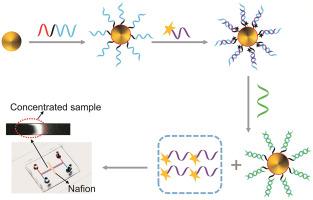Journal of Pharmaceutical Analysis ( IF 8.8 ) Pub Date : 2022-06-01 , DOI: 10.1016/j.jpha.2022.05.009 Jun Xu 1 , Qing Tang 1 , Runhui Zhang 1 , Haoyi Chen 2 , Bee Luan Khoo 3 , Xinguo Zhang 1 , Yue Chen 1 , Hong Yan 1 , Jincheng Li 1 , Huaze Shao 1 , Lihong Liu 1

|
The identification of tumor-related microRNAs (miRNAs) exhibits excellent promise for the early diagnosis of cancer and other bioanalytical applications. Therefore, we developed a sensitive and efficient biosensor using polyadenine (polyA)-mediated fluorescent spherical nucleic acid (FSNA) for miRNA analysis based on strand displacement reactions on gold nanoparticle (AuNP) surfaces and electrokinetic signal amplification (ESA) on a microfluidic chip. In this FSNA, polyA-DNA biosensor was anchored on AuNP surfaces via intrinsic affinity between adenine and Au. The upright conformational polyA-DNA recognition block hybridized with 6-carboxyfluorescein-labeled reporter-DNA, resulting in fluorescence quenching of FSNA probes induced by AuNP-based resonance energy transfer. Reporter DNA was replaced in the presence of target miRNA, leading to the recovery of reporter-DNA fluorescence. Subsequently, reporter-DNAs were accumulated and detected in the front of with Nafion membrane in the microchannel by ESA. Our method showed high selectivity and sensitivity with a limit of detection of 1.3 pM. This method could also be used to detect miRNA-21 in human serum and urine samples, with recoveries of 104.0%–113.3% and 104.9%–108.0%, respectively. Furthermore, we constructed a chip with three parallel channels for the simultaneous detection of multiple tumor-related miRNAs (miRNA-21, miRNA-141, and miRNA-375), which increased the detection efficiency. Our universal method can be applied to other DNA/RNA analyses by altering recognition sequences.
中文翻译:

使用聚腺嘌呤介导的荧光球形核酸和微流控电动信号放大芯片对 microRNA 进行灵敏检测
肿瘤相关微小 RNA (miRNA) 的鉴定对于癌症的早期诊断和其他生物分析应用具有极好的前景。因此,我们基于金纳米颗粒 (AuNP) 表面上的链置换反应和微流控芯片上的电动信号放大 (ESA) 开发了一种使用聚腺嘌呤 (polyA) 介导的荧光球形核酸 (FSNA) 进行 miRNA 分析的灵敏高效的生物传感器。在这个 FSNA 中,polyA-DNA 生物传感器通过腺嘌呤和 Au 之间的内在亲和力锚定在 AuNP 表面。直立构象 polyA-DNA 识别块与 6-羧基荧光素标记的报告基因 DNA 杂交,导致基于 AuNP 的共振能量转移诱导的 FSNA 探针的荧光猝灭。在存在靶 miRNA 的情况下,报告 DNA 被替换,导致报告基因-DNA 荧光的恢复。随后,报道基因在微通道中的Nafion膜前部被ESA积累和检测。我们的方法显示出高选择性和灵敏度,检测限为 1.3 pM。该方法还可用于检测人血清和尿液样本中的 miRNA-21,回收率分别为 104.0%–113.3% 和 104.9%–108.0%。此外,我们构建了一个具有三个平行通道的芯片,用于同时检测多种肿瘤相关miRNA(miRNA-21、miRNA-141和miRNA-375),提高了检测效率。我们的通用方法可以通过改变识别序列应用于其他 DNA/RNA 分析。ESA 在微通道中的 Nafion 膜前积累和检测报告基因 DNA。我们的方法显示出高选择性和灵敏度,检测限为 1.3 pM。该方法还可用于检测人血清和尿液样本中的 miRNA-21,回收率分别为 104.0%–113.3% 和 104.9%–108.0%。此外,我们构建了一个具有三个平行通道的芯片,用于同时检测多种肿瘤相关miRNA(miRNA-21、miRNA-141和miRNA-375),提高了检测效率。我们的通用方法可以通过改变识别序列应用于其他 DNA/RNA 分析。ESA 在微通道中的 Nafion 膜前积累和检测报告基因 DNA。我们的方法显示出高选择性和灵敏度,检测限为 1.3 pM。该方法还可用于检测人血清和尿液样本中的 miRNA-21,回收率分别为 104.0%–113.3% 和 104.9%–108.0%。此外,我们构建了一个具有三个平行通道的芯片,用于同时检测多种肿瘤相关miRNA(miRNA-21、miRNA-141和miRNA-375),提高了检测效率。我们的通用方法可以通过改变识别序列应用于其他 DNA/RNA 分析。回收率分别为 104.0%–113.3% 和 104.9%–108.0%。此外,我们构建了一个具有三个平行通道的芯片,用于同时检测多种肿瘤相关miRNA(miRNA-21、miRNA-141和miRNA-375),提高了检测效率。我们的通用方法可以通过改变识别序列应用于其他 DNA/RNA 分析。回收率分别为 104.0%–113.3% 和 104.9%–108.0%。此外,我们构建了一个具有三个平行通道的芯片,用于同时检测多种肿瘤相关miRNA(miRNA-21、miRNA-141和miRNA-375),提高了检测效率。我们的通用方法可以通过改变识别序列应用于其他 DNA/RNA 分析。

























 京公网安备 11010802027423号
京公网安备 11010802027423号